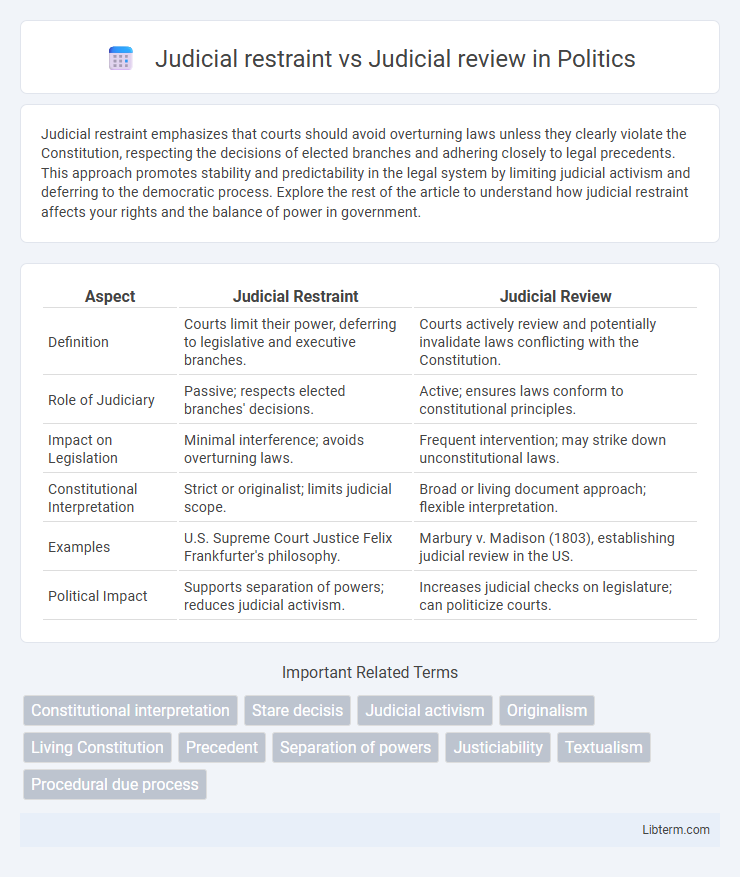Judicial restraint emphasizes that courts should avoid overturning laws unless they clearly violate the Constitution, respecting the decisions of elected branches and adhering closely to legal precedents. This approach promotes stability and predictability in the legal system by limiting judicial activism and deferring to the democratic process. Explore the rest of the article to understand how judicial restraint affects your rights and the balance of power in government.
Table of Comparison
| Aspect | Judicial Restraint | Judicial Review |
|---|---|---|
| Definition | Courts limit their power, deferring to legislative and executive branches. | Courts actively review and potentially invalidate laws conflicting with the Constitution. |
| Role of Judiciary | Passive; respects elected branches' decisions. | Active; ensures laws conform to constitutional principles. |
| Impact on Legislation | Minimal interference; avoids overturning laws. | Frequent intervention; may strike down unconstitutional laws. |
| Constitutional Interpretation | Strict or originalist; limits judicial scope. | Broad or living document approach; flexible interpretation. |
| Examples | U.S. Supreme Court Justice Felix Frankfurter's philosophy. | Marbury v. Madison (1803), establishing judicial review in the US. |
| Political Impact | Supports separation of powers; reduces judicial activism. | Increases judicial checks on legislature; can politicize courts. |
Introduction to Judicial Restraint and Judicial Review
Judicial restraint emphasizes limiting courts' power by deferring to legislative and executive branches unless laws clearly violate the Constitution. Judicial review allows courts to evaluate the constitutionality of laws and government actions, serving as a critical check on legislative and executive authority. The balance between judicial restraint and judicial review shapes the judiciary's role in upholding constitutional principles while respecting democratic governance.
Defining Judicial Restraint
Judicial restraint is a legal philosophy that urges judges to limit their own power by deferring to the decisions of legislative and executive branches unless there is a clear violation of the Constitution. It emphasizes respect for precedent (stare decisis) and avoids overturning laws unless absolutely necessary, promoting stability in the legal system. This contrasts with judicial review, where courts actively interpret and invalidate government actions that conflict with constitutional principles.
Understanding Judicial Review
Judicial review is the constitutional principle that empowers courts to evaluate the legality and constitutionality of legislative and executive actions, ensuring alignment with the Constitution. It serves as a critical check on government power, allowing courts to invalidate laws and policies that violate constitutional provisions. This authority, established by landmark cases such as Marbury v. Madison, maintains the balance of power and protects individual rights against governmental overreach.
Historical Origins of Judicial Review
Judicial review originated in the early 19th century with the landmark U.S. Supreme Court case Marbury v. Madison (1803), establishing the judiciary's authority to invalidate unconstitutional laws. Judicial restraint emphasizes courts' limited role in overturning legislation, deferring to elected branches unless clear constitutional violations occur. This principle contrasts with the proactive stance of judicial review, which empowers courts to interpret and enforce constitutional limits on government power.
Key Principles of Judicial Restraint
Judicial restraint emphasizes the principle that courts should defer to legislative and executive branches unless there is a clear violation of the Constitution, promoting respect for democratic decision-making. It advocates for judges to interpret laws narrowly, avoid creating new policies, and maintain stability by upholding precedent, also known as stare decisis. This approach limits judicial activism, ensuring that courts do not overstep their constitutional role and preserve the balance of powers among government branches.
Advantages of Judicial Restraint
Judicial restraint promotes stability and respect for legislative decisions by limiting courts to interpreting existing laws rather than creating new policies, thereby preserving democratic principles and preventing judicial overreach. It encourages deference to elected branches, which enhances the separation of powers and safeguards against the judiciary becoming a political actor. This approach minimizes judicial activism and fosters consistency in legal interpretations, contributing to predictable legal outcomes.
Limitations of Judicial Review
Judicial review faces limitations such as reliance on existing legal frameworks, which restricts courts from creating new laws or policies beyond constitutional interpretation. Courts often exercise self-restraint to avoid conflicts with legislative and executive branches, maintaining the balance of power essential in a democratic system. Additionally, judicial review cannot address issues where statutes grant broad discretion or where enforcement depends on political processes beyond judicial control.
Landmark Cases Illustrating Both Approaches
Landmark cases illustrating judicial restraint include *Plessy v. Ferguson* (1896), where the Supreme Court upheld racial segregation under the "separate but equal" doctrine, emphasizing limited judicial intervention in social policy. In contrast, *Brown v. Board of Education* (1954) showcases judicial review, as the Court actively overturned segregation laws, declaring them unconstitutional and reshaping civil rights jurisprudence. These cases highlight the tension between deference to legislative decisions and proactive constitutional interpretation shaping U.S. law.
Impact on Separation of Powers
Judicial restraint emphasizes courts' limited role in overturning laws, preserving legislative and executive authority while maintaining the separation of powers. Judicial review empowers courts to invalidate laws that violate the Constitution, acting as a crucial check on legislative and executive branches. This dynamic balances governmental powers by ensuring laws adhere to constitutional principles without allowing judicial overreach.
The Ongoing Debate: Judicial Restraint vs Judicial Review
The ongoing debate between judicial restraint and judicial review centers on the proper role of courts in interpreting the Constitution, with judicial restraint advocating for limited judicial intervention and deferring to legislative decisions. Judicial review empowers courts to invalidate laws conflicting with constitutional principles, ensuring checks and balances within government. This debate critically shapes the judiciary's influence on public policy, constitutional interpretation, and the protection of individual rights.
Judicial restraint Infographic

 libterm.com
libterm.com